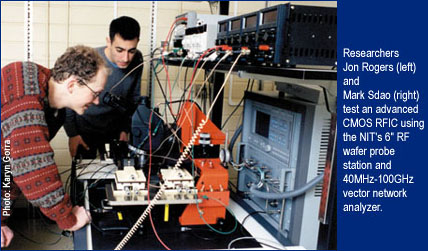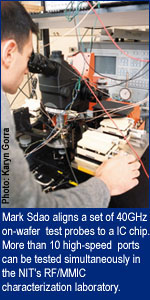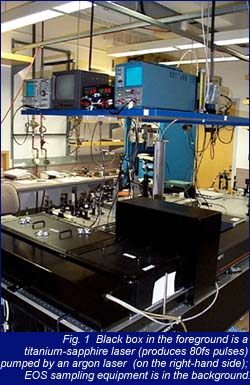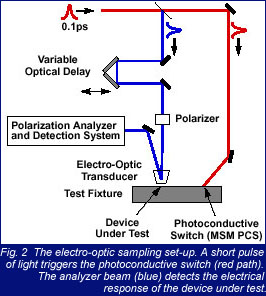
NIT >> Newsletter
@NIT, Spring 2001
|
|
In this issue: Director’s Message MET: The convergence of telecom engineering, business and law NIT Scholarship Winner NIT Advanced Wireless Breakthrough Revealing secrets Announcements |
Director's Message
Welcome to this issue of our newsletter focusing on NIT’s educational components.
Our unique Master of Engineering in Telecommunications (MET) program was set up in 1998 as part of the original agreement between Nortel Networks and the University of Toronto. Professor Al Leon-Garcia (the original holder of the NIT Chair in Network Architecture and Services, and the inaugural director of the MET program) chaired a committee that developed the curriculum. This curriculum was later approved by the Graduate School and the Ontario Council for Graduate Studies.
The program has grown over the past 3 years to the point where the number of applicants to the program last year exceeded 100. The number of students accepted, however, is constrained by the MET Advisory Board recommendation to keep class sizes small in order to maximize the learning and networking experience of the program.
Drawing on the success of the MET program, the current director, Professor Tony Yuen, has prepared a new Executive Development Program to be offered this summer (see page 8 for details). The program is a condensed telecommunications and IT industry overview, aimed at mid- to upper-level telecommunications managers to update their knowledge in this rapidly evolving field.
On other fronts, our Distinguished Lecture series continues to present excellent speakers, addressing a broad spectrum of topics relating to telecommunications. A recent lecture by Professor Alex Jadad brought together health professionals and engineers to hear a challenging vision of improvements to health-care delivery that could be achieved by exploiting Internet technology. Further details can be found in the article “Towards eHealth” on page 3. Professor Jadad’s lecture is available at the video archive on the NIT website.
As part of our continuing efforts to develop international collaborations, NIT will be one of the sponsors (together with CNRS, the French national research centre, and NRC Canada) of the upcoming Canada-France Conference on Molecular Photonics and Plastic Electronics, October 15-17, 2001, at Château Montebello, Quebec. Our NIT organic and polymer optoelectronics laboratory (OPOL) facilities are nearing completion, and experimental studies are being initiated by NIT researchers using samples provided by our colleagues in France and several Canadian universities.
In the coming months, we will be announcing an “NIT day” to be held in July, with talks by NIT researchers and associates, together with opening ceremonies for the two new NIT OPOL laboratories. There is also a series of one-day workshops on specialized technical topics in the works. The series will begin with a MEMS workshop planned for the early fall. Stay tuned.
MET: The convergence of telecom engineering, business and law
Today’s telecommunications environment consists of a complex array of competing technologies, standards, regulations, business models, and network and service visions, all evolving at breakneck speed. A vital part of the Nortel Institute’s mission to provide global leadership in the field, our Master of Engineering Telecommunications (MET) program prepares telecommunications and networking professionals to practice in this fast changing environment.
Established in 1998 under the auspices of the NIT, the MET followed on many years of collaboration between the University of Toronto and industry in the area of network engineering education through a summer Network Engineering program begun by Prof. Alberto Leon-Garcia, inaugural director of the MET. From the start, the program was innovative and focused, designed and supervised by international experts in the broad field of telecommunications. The program offers advanced education in such technical areas as network architecture, optoelectronics, digital signal processing, wireless communications, and hardware and software design. In addition, however, MET’s unique feature is that it also encompasses legal and regulatory issues, management, and new business paradigms, says Professor Anastasios N. Venetsanopoulos, Dean designate of the Faculty of Applied Science and Engineering, and a member of the committee that created the MET program.
The curriculum provides a strong foundation in both fundamental concepts and current issues and developments, through diverse but complementary experiences. It consists of a full term of immersion in networking and telecommunications, a specialization term provided by graduate courses from Canada’s most research-intensive university, and a project term normally carried out in industry and as part of a team. Courses are taught by faculty from across the University-Electrical and Computer Engineering, Faculty of Law, and Rotman School of Management-as well as industry professionals. The program is guided by the MET Advisory Board consisting of leaders at the University, industry and government (see inset page 6). Based on the numbers of qualified registrations, the success of the program has been phenomenal.
Venetsanopoulos points to another great strength of the program-it allows people already in industry a chance to return to university to upgrade their skills and knowledge. This helps promote a fertile and stimulating learning environment for all participants. And finally, he stresses that the small class size will continue to guarantee a very high quality of interaction among professors, industry professionals, and students.
In this newsletter you will find additional articles about the business and regulatory aspects of the program. For further information about the MET program, faculty, courses, and registration, visit www.nal.utoronto.ca/met.
Regarded as one of Canada’s leading experts on international competitiveness, Professor Joseph D’Cruz is ideally suited to teach business management and technology. His strong personal interest in technology, combined with an understanding at a high-systems level of the technology, allow him to deliver information in a manner accessible to people from the engineering world.
Several years ago, Professor Alberto Leon-Garcia had introduced a management component to the Network Engineering Program and invited D’Cruz to teach. Over time, and with the current Director, Professor Tony Yuen, D’Cruz notes, “We have made significant progress in bringing the management component into alignment with the engineering components.”
According to D’Cruz, “One of the strengths of the MET program is its ability to integrate the viewpoints of engineering with law and management. It is this integrated view that helps the students move from the first stage of their career, where they are highly dependent on their technical knowledge, to a new stage where they are aspiring to combine the technical knowledge with the business acumen and awareness of legal aspects of organization.”
D’Cruz teaches business management by case methods, using examples of companies that have been successful in the global environment. These tend to be American companies, such as Dell, Amazon, and Microsoft. Among Canadian companies, there are few examples but all are successful because they operate on a global level. He believes that defining a company’s market scope as purely Canadian is a recipe for failure. “The rules of the game are definitely changing,” says D’Cruz. “The previous business models of economies of scale don’t help you very much in the new economy.”
What do “scarcity of spectrum,” “IT privacy,” “Hush-a-Phones,” and “rights of way” have in common? All act as examples to highlight the dynamic synergy between law and engineering, as taught by Professor Hudson N. Janisch.
Janisch has been teaching communications and telecommunication law for many years. Ten years ago, he was invited to participate in the summer Network Engineering Program. He enjoyed it, specifically because it presented an opportunity for exchange. “I could broaden engineering students’ understanding by talking about legal developments and they, in turn, could tell me about the technical developments that drive the law’s response,” says Janisch. This interactivity is one of the strengths of the program. Indeed, this past year, two MET engineering students took a course in regulation as an elective at the Faculty of Law and found themselves helping the law students with some of the technical issues important to understanding legal regulation.
By its nature, law tends to be protective of the existing technologies and situations, and technological justifications have certainly been used as a basis for legal regulation. For example, from the 1960s to 1980s, as monopolies moved to a more competitive situation, the telephone companies used law to protect their monopolies, as in the Hush-a-Phone case in the USA.
In the current stage of telecom evolution, however, shifts in technology undermine the rationale for the legal regime and in turn change the status quo. The law has acted as the facilitator of change in regulatory decisions. Lawyers are likely to be aware that, to be effective, legal rules must be congruent with technological capabilities and economic incentives. For example, issues of rights of away as preferred transmission technology have changed from copper to microwave/satellite and then to optical fibres.
The dynamic nature of law and engineering and the concept that law is not neutral-that you can use law-are difficult concepts for engineering students. “At the moment, we are using law to facilitate liberalization and competition, but in an earlier era, law was used to protect telecom monopoly,” states Janisch. However, in many cases, the formal laws have not changed; it is how the law is interpreted and applied that has changed.
Now that technological and economic convergence is a reality, Janisch says that the law is in state of introspection as to how to design new legal regimes to accommodate accelerated technological and social change. He sees technology creating powerful currents that the law should guide and steer, rather than control. Through the MET program, Janisch encourages students to think about these issues.
Shifting student interest
Both Professors Janisch and D’Cruz have noted a definite shift in student interest. When Janisch began, the students were largely Bell Canada or Northern Telecom employees or students who were thinking of careers in large telecom entities. “Today’s crop of students is much more of the dot-com variety,” he says. “Most of them don’t think of themselves as being within large companies but more likely with smaller competitors. Naturally, they are more interested in intellectual property, software, and business issues. This makes teaching more challenging, because the nature of the legal regime governing telecom has broadened significantly to include copyright, patents, and competition law.”
D’Cruz also sees many MET students considering setting up their own businesses or participating in start-up IT businesses. He sees this as a distinct and very positive change: “This is extraordinarily healthy for the country. When you look at technology clusters in the world, it is clear that growth and development are very much a function of the health of the small business sector. Many of the new technologies and the new ways of doing business are developed initially in small start-up companies. If Canada is to continue to prosper in telecommunications, IT, and the convergence that is happening between them, then it is critical that we have a vibrant small sector.”
Students in the MET program are exactly at the point in their careers when they are at the peak of their technical competence, with the capability of taking off on new trajectories. D’Cruz aims to enhance student interest in the business planning process towards new enterprises and new business. He believes that if we see such successes coming out of MET, it will be a significant achievement for the University.
Because MET is both focused and comprehensive, it can meet the current and ongoing educational needs of a wide range of students and practicing professionals. Indeed, the program’s success could be measured not only by the variety of students it attracts but also by the variety of ways they exploit their training in companies large or small, established or start-up.
Cooking up “the next big thing”
In the fall of 1999, a group of students in the Master of Engineering in Telecommunications (MET) program were kicking around ideas for “life after school”. The students, including Sam AbdelMalek and Rahim Kassam (photo page 1), discovered they shared an interest and an ambition to develop a “cool” new technology for an under-exploited field. They wanted to use the knowledge they were gaining in the MET program to start a new venture to develop and market what they hoped would be “the next big thing”.
As part of an MET project, the student group wrote a small application in the spring of 2000. The application enabled the viewing of personal e-mails on any web-enabled phone. Eventually the application was put on-line, and based on positive feedback for it, the students decided to form a company. By the summer, Sam and Rahim had become two of the co-founders of SmartK Wireless Solutions Inc.
Called “m-force,” SmartK’s mobile computing platform enables an enterprise to provide its workforce and customers with access to its intranet data and corporate data through web, wireless, or voice-enabled services. “As we started to build and enhance the features of the application, we learned more about the IT industry itself, both the technical and business sides. Knowledge learned from our MET courses was put to practical use in building the application and company,” says Rahim.
Sam adds: “We didn’t join the program with the idea of starting our own venture. But when our group came together, each student with his own technical skills, and the MET knowledge was added, we realized we could do it. You could say that MET was the pot where all these ingredients were put together and, with the help of our ‘seasoned’ profs, we were able to start the journey. Currently, our company is committed to researching solutions and services for next-generation telecommunications networks.”
“This is definitely a success for the program,” says Professor Tony Yuen, MET Director. “The MET is unique in North America: students learn about technical, regulatory, and new business paradigms of telecom. The program leverages on the strengths of the university and its industry partners through lectures that are delivered by leading academics, industry experts, and top executives. The opportunity to network with professionals, as well as with other students in a University setting, provides a broad view of the telecom industry.”
The MET program has truly provided the environment for the knowledge and expertise required and has helped pave the way for SmartK’s success. Both Sam and Rahim believe that MET professors gave them vital help through the initial growing stages of their company, sharing their time, expertise, and insights.
More info:
MET: http://www.nal.utoronto.ca/met
SmartK: http://www.smartk.com
NIT Scholarship Winner
|
“To be selected from such a deserving field of candidates is a great honour-communication is an essential part of our society and I relish the opportunity to work in such a dynamic and exciting industry,” said Joan Grant, third year, in Engineering Science at the University of Toronto, this year’s recipient of the Nortel Institute Undergraduate Student Scholarship.
As part of the Institute’s establishment, Nortel Networks, with matching funds from the University and the Government of Ontario, has endowed a permanent scholarship in support of undergraduate students in the Faculties of Applied Science and Engineering, Arts and Science, and Management. One award a year, with a projected value of approximately $6,000, is made to an outstanding student in accordance with the University’s policy on student awards. The scholarship also includes a summer work-term with Nortel Networks. Congratulations, Joan! |
|
NIT Advanced Wireless Breakthrough
NIT Advanced Wireless researchers Prof. John Long, James Maligeorgos, Jon Rogers, and Mark Sdao, have developed silicon microchip-compatible transformers to implement the high frequency section of a very sensitive, energy efficient radio transceiver. This research work has led to a breakthrough in the integration for radio circuits onto silicon ICs. It demonstrates that many parts of the conventional cellular telephone can be pulled onto a single silicon chip that can be produced cheaply and in large volumes. This capability makes it possible to design lower cost and higher speed versions of such radio receivers, supporting the rapidly expanding field of cellular telephony. In order to achieve this, computer-aided design tools, circuits, and techniques to realize on-chip inductors and transformers were developed and demonstrated.
  The results of this work were published at the 2000 International Solid-State Circuits Conference (ISSCC 2000) and as an invited paper in the December 2000 issue of the IEEE Journal of Solid-State Circuits. The ISSCC 2000 work also won the Jack S. Kilby Best Paper Award. This is the first time that this award has ever been given to researchers at a Canadian university and is a great coup given that ISSCC is the most prestigious conference in the area of chip design. The results of this work were published at the 2000 International Solid-State Circuits Conference (ISSCC 2000) and as an invited paper in the December 2000 issue of the IEEE Journal of Solid-State Circuits. The ISSCC 2000 work also won the Jack S. Kilby Best Paper Award. This is the first time that this award has ever been given to researchers at a Canadian university and is a great coup given that ISSCC is the most prestigious conference in the area of chip design.
|
Towards eHealth
"The health system provides unparalleled opportunities to understand and influence the role that technology plays in society,” began Dr. Alejandro (Alex) Jadad, introducing his NIT Distinguished Lecture, Towards eHealth: the promise, perils and paradoxes of telecommunications in the health system. The lecture, presented in January, was jointly sponsored by the Nortel Institute and the Edward S. Rogers Sr. Department of Electrical and Computer Engineering.
Jadad believes that new technologies promise opportunities for more rapid, effective, and wider organization and exchange of health knowledge. Unlike any other era, massive amounts of information-both scientific and experiential-are available. It is no longer this availability that determines the quality of decisions, but how the information is accessed, interpreted, exchanged, integrated, and applied by all the interested parties.
“One of my research interests is the development and evaluation of unique strategies to enhance the health system, through state-of-the-art technology, to help people access and use the knowledge and services they require to meet their needs,” says Jadad. “The information age is creating many new challenges and perils. Thinking that fancy technology and information will lead, on their own, to a richer, more efficient, balanced, humane and equitable health system-public relationship has proven naïve. The rapid developments in information technology are outpacing the ability of the system to keep up. Most health-related programs and health care systems were built for the pre-Internet era. The level of connectivity and compatibility of the computer systems across organizations that provide health services, and often among components of the same organization, is poor. Policy makers and managers are unable to monitor the impact of technology on health-related issues or to respond to the opportunities to improve health services created by new technology."
Jadad presented data from studies that have evaluated the impact of technology on the public-health system relationship and highlighted the main lessons learnt from ongoing projects that explore, with input from patients and health care providers, the role of the Internet on the health system. He concluded that overcoming existing barriers that are hindering the full potential of technology will require substantial changes in the levels of health literacy of the general population, in the structure and politics of the health system, and even in the way in which humans think and behave.
You can find our more about Dr. Jadad and view the lecture by visiting the NIT video archive at
www.nit.utoronto.ca/educ/webcast.htm
Revealing secrets
 Researchers at the University of British Columbia and the University of Toronto have harnessed the high-speed inherent in optical pulses to improve their capability of analyzing ultra-fast electronic devices and circuits.
Researchers at the University of British Columbia and the University of Toronto have harnessed the high-speed inherent in optical pulses to improve their capability of analyzing ultra-fast electronic devices and circuits.
Conventional measurement methods rely on electronic instrumentation built upon principles used in conventional radios, updated to use modern electronic technology. “This is the contradiction inherent in trying to measure very fast signals,” says Professor Mike Jackson of UBC, “We must rely on today’s technology to examine tomorrow’s components.” The technique of electro-optic sampling was adapted by Jackson and Dr. Jiaming Zhang at UBC’s ultrafast microelectronics lab and combined with the expertise in microelectronics and fast measurement in the RF/MMIC Group at the University of Toronto’s Nortel Institute.
“Jackson and Zhang can produce ultra-fast light pulses using their laser source,” explained Professor John Long of UofT (Figs. 1 and 2). The light signal is then converted to an electrical impulse that’s used to probe the circuit. “The resulting echo is a signature of the component’s electrical behaviour that’s similar to the electrical signatures analyzed by an aircraft radar,” says Long, “where the echos provide navigating information for the pilot.”
After computer enhancement and processing of the echo signal, the underlying electrical properties are revealed. “The key to the work is in the computer processing we’ve developed to analyze the raw measured data,” explains Zhang. “It really allows us to look beyond what is possible with current technology.” The result is a measurement system with over 300GHz bandwidth, or 3x the capability of the best electrical systems on the market today.
Accurate high-speed measurements are needed to support the continued development of silicon-based circuits for the next generation of applications, like 40GB/s datacomm and 26-28GHz (LMDS) broadband wireless networks. Using the laser-based technique, picosecond electrical waveforms are generated and then measured. The frequency response is then calculated using the Fourier transform. Deembedding, which removes small inaccuracies in the measurements, is essential to see the intrinsic device or circuit’s response. When working at frequencies as high as 300GHz, conventional deembedding fails, so a new approach based on interconnect modeling, using 3-D electromagnetic simulation, was developed specifically for this work. With this capability in hand, the performance, of ultrafast SiGe hetero-hetero-junction transistors and planar transmission lines (Fig. 3) manufactured by IBM Microelectronics were analyzed.

The study revealed many previously inaccessible high-frequency characteristics, such as the phase response and base resistance. Since the technique is easily extendable to more complicated circuits, research is now under way to examine the inner workings of key high-speed circuit blocks and new types of on-chip interconnections made possible by micromachining (MEMS) technology. “This is the kind of work that really pushes back frontiers,” says Long. “We’re looking at things people haven’t been able to see before, and that’s bound to reveal a few secrets.”
This research work was supported by
Micronet, NSERC, Nortel Networks, Gennum, and the Nortel Institute
Announcements
A bustling construction area and three towering cranes can be seen on the UofT downtown campus, just northeast of College and St. George Streets. If you look up and squint a bit, you can envision the future home of the NIT Open Research Facility on the 7th floor of the Bahen Centre for Information Technology.
Construction of the Bahen Centre is progressing very quickly, with construction of walls, columns, and slabs for second and third floors currently proceeding. The eight-storey structure, slated for completion in March 2002.
- Approx. 40 contracts to various trades have been issued for the 88.8 million dollar project.
- On average there are 110 trades people working on-site every day.
- Approx. 11,500 cubic metres of concrete have been placed, accounting for approx. 1,440 concrete trucks in and out of the site.
- Approx. 2.2 million pounds of reinforcing steel have been placed in the concrete.
- The NIT Open Research Facility will cover an area of 900 square metres, including cleanrooms, network architecture testbeds, baseband signal and microwave/RF, and millimetre-wave processing labs.
|
|
